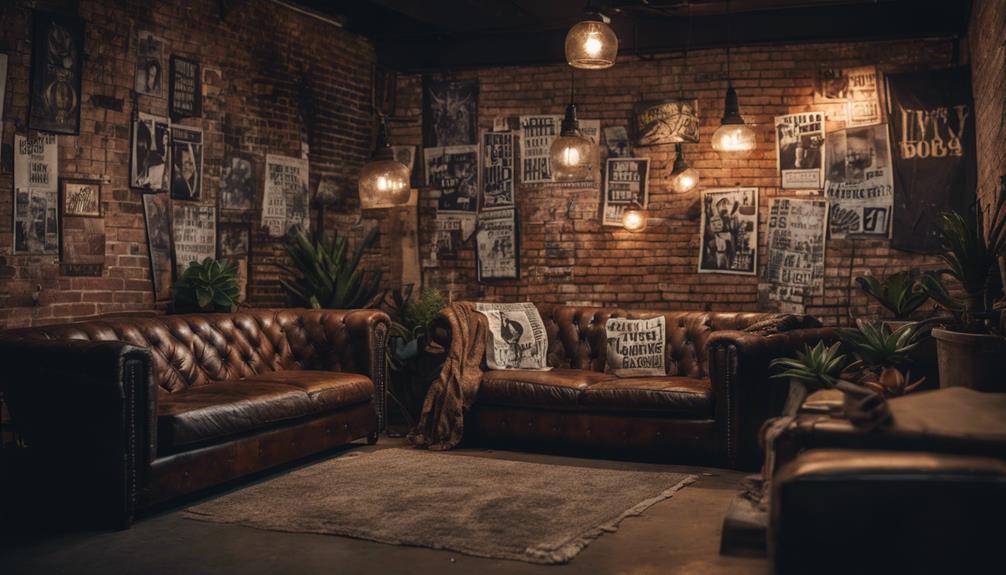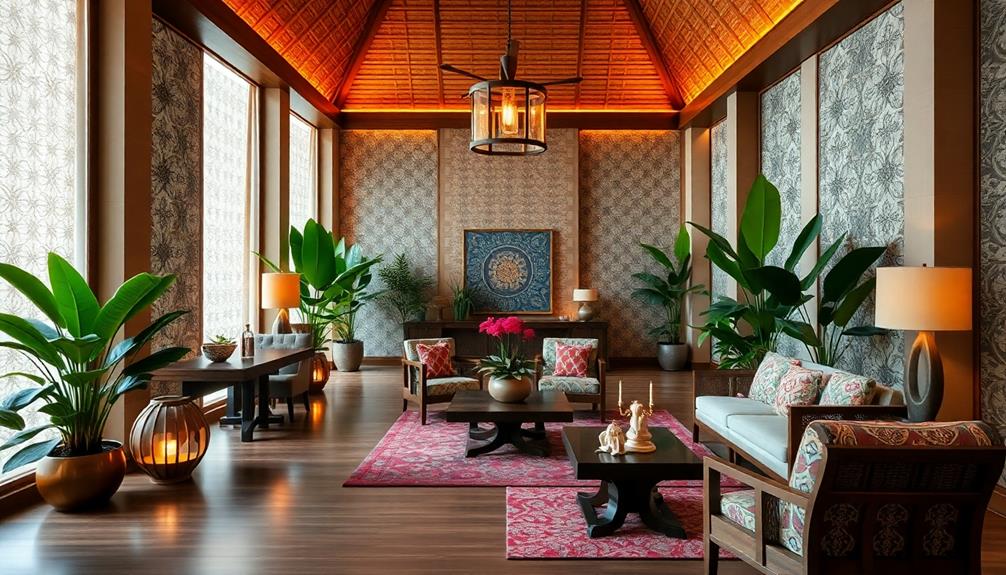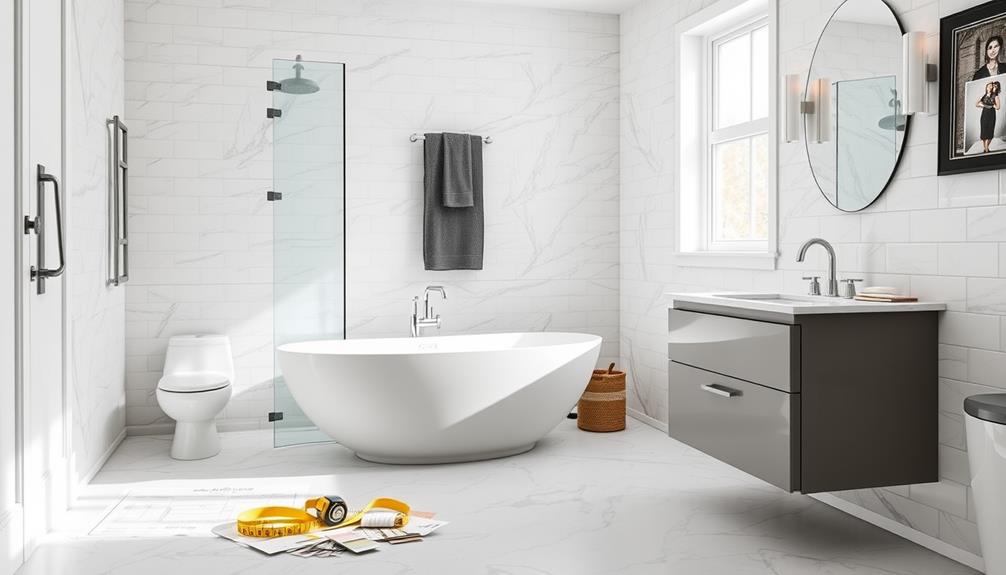Grunge room decoration allows you to express your unique style in a bold way. Combine dark colors like blacks and browns with vibrant accents in rich reds or greens to create a distinctive look. Use distressed materials such as reclaimed wood and vintage furniture for an authentic feel. Layer different textures like velvet and leather for added dimension. Incorporate industrial lighting and vintage band posters to give the space personality. Adding rustic elements like woven wall tapestries can completely transform the room. If you want more tips on achieving the perfect grunge aesthetic, there is plenty of inspiration waiting for you!
Key Elements
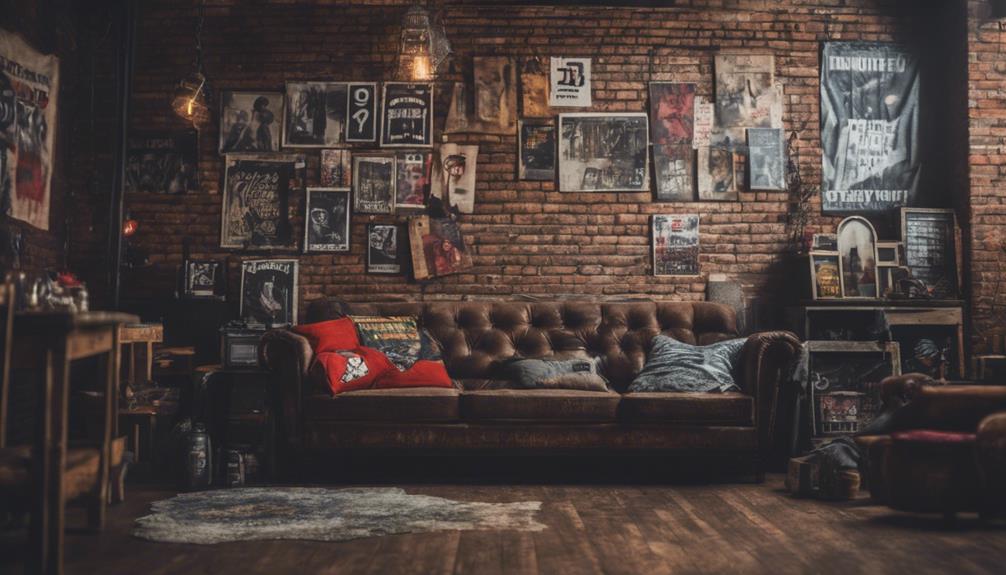
When you create a grunge room, focus on your color scheme, materials, and textures.
You'll want to mix muted tones with bold accents while using natural and distressed materials to enhance the look.
Layering different textures adds depth, making your space feel both inviting and edgy.
Color Scheme
The grunge color scheme revolves around a mix of neutral tones like blacks, grays, and browns, enhanced by bold accents in deep reds, greens, and blues to create an eye-catching contrast. This combination forms the foundation of your home decor, establishing an edgy yet stylish vibe that defines the grunge decor aesthetic.
To achieve this look, consider incorporating earthy textures and tones, allowing muted hues to interact seamlessly with raw elements. Dark shades evoke mood and depth, while layering these with softer accents helps to balance the overall design, adding warmth to the space.
Don't shy away from clashing colors and patterns; they're essential to grunge decor, creating a disorganized yet charming visual that reflects your individuality.
Modern grunge interpretations even introduce pastel shades, offering a 'pastel grunge' aesthetic that maintains the style's essence while lightening the atmosphere. Embrace these elements in your room, mixing and matching until you find a color scheme that resonates with you.
With the right palette, your space won't only wow everyone but also serve as a true representation of your unique personality.
Materials
To achieve that authentic grunge vibe, focus on incorporating raw and distressed materials like reclaimed wood and aged metal throughout your space. These elements not only enhance the rugged aesthetic but also add character and warmth. Reclaimed wood can be used for furniture, shelving, or even accent walls, creating a striking focal point.
Don't shy away from distressed materials either. Look for vintage furniture that tells a story, whether it's a weathered coffee table or a quirky chair. Each piece adds uniqueness to your decor while reinforcing that grunge style. Pair these with industrial-style lighting fixtures, such as oversized metal pendant lights or distressed wire mesh lamps, to further enhance the atmosphere.
Layering materials is essential in grunge decor. Combine jute rugs with distressed fabrics to create depth and warmth while maintaining an eclectic feel. Earthy color tones will pull the look together, balancing the harsher elements with softer textures.
Textures
Incorporating a variety of textures is essential for achieving that inviting yet edgy grunge aesthetic in your space. Start by layering different materials like velvet, leather, and wool. This combination creates an eclectic atmosphere that enhances both comfort and visual interest.
You can add distressed fabrics for throws and rugs over flooring to introduce depth and warmth, which are vital to the rugged appeal of grunge style.
Don't shy away from unique and rough textures, such as reclaimed wood and faux concrete elements. These materials contribute greatly to the industrial vibe that defines grunge decor.
Mixing various fabric types, patterns, and oversized textiles also helps cultivate a cozy ambiance while maintaining that signature edgy charm.
Essential Fixtures and Furniture
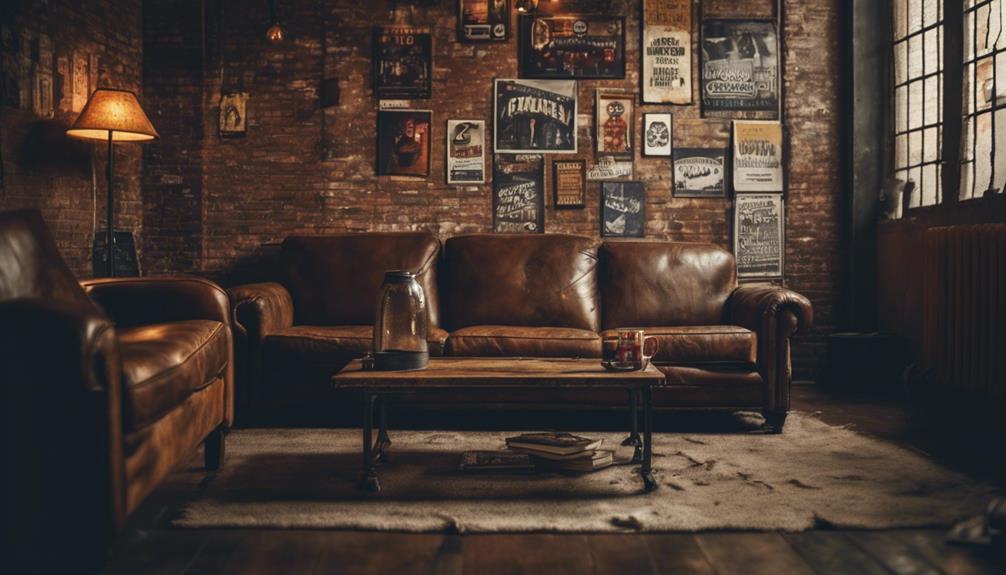
To create a true grunge vibe, you'll want to focus on essential fixtures and furniture.
Vintage industrial pipe shelving adds a rugged charm, while reclaimed metal pipe shelving can give your space an edgy touch.
Don't forget about vintage Edison bulb fixtures to provide warm, atmospheric lighting that complements your unique style.
Vintage Industrial Pipe Shelving
Vintage industrial pipe shelving adds a rugged charm to your space, combining steel pipes and reclaimed wood to create a stylish and functional storage solution. These shelves are perfect for showcasing your favorite pieces of artwork, vintage finds from garage sales, or personal mementos. Their customizable nature allows you to adapt them to fit any area, ensuring they enhance the unique character of your room.
Installing these shelves is easy, making them an ideal DIY project for anyone looking to elevate their decor without a major renovation. You can arrange them in various configurations, turning blank walls into functional art displays.
The combination of distressed wood and raw steel not only contributes to the grunge aesthetic but also reflects a commitment to sustainability by repurposing materials.
Reclaimed Metal Pipe Shelving
Combining industrial aesthetics with sustainability, reclaimed metal pipe shelving offers a unique way to showcase your favorite items while enhancing the grunge vibe of your space. These shelves, crafted from salvaged materials, bring a rugged charm that fits perfectly with your eclectic decor.
Take a look at how their raw, unfinished look complements softer textures commonly found in grunge design.
You'll love the versatility of metal pipe shelving, as it can be customized to various sizes and configurations. Whether you have a small nook or a spacious wall, you can create an arrangement that suits your style and needs.
These sturdy shelves provide robust support for everything from books to plants, ensuring your treasured items are displayed safely.
Installing reclaimed metal pipe shelving is a straightforward DIY project, allowing you to personalize your space easily. This hands-on approach helps you create a statement piece that resonates with your values and aesthetic.
Vintage Edison Bulb Fixtures
Reclaimed metal pipe shelving sets the stage for showcasing stunning vintage Edison bulb fixtures, which bring a warm, amber glow and industrial charm to your grunge-inspired room.
These fixtures, with their exposed filaments, create a nostalgic atmosphere that perfectly complements the rugged aesthetic of grunge decor. Whether you opt for pendant lights, wall sconces, or a bold chandelier, you can easily find a style that resonates with your space.
To enhance that edgy vibe, choose fixtures with metal or distressed finishes. Not only do they align with the overall look, but they also add character to your decor. Plus, many vintage Edison bulbs come in energy-efficient LED options, so you can enjoy that inviting light while keeping your energy costs down.
Incorporating dimmers with your Edison bulb fixtures allows you to adjust the ambiance. You can shift from a bright, lively atmosphere to a moody, intimate setting with just a flick of a switch.
This versatility is vital for creating the right mood in your grunge room, making vintage Edison bulb fixtures essential for achieving the perfect blend of style and function.
Lighting Ideas

When it comes to lighting your grunge room, you'll want to choose fixtures that enhance the edgy vibe.
Think about incorporating vintage neon signs, exposed bulb pendants, or rustic string lights to create an inviting atmosphere.
Don't forget graffiti-inspired wall sconces for that perfect touch of urban flair!
Vintage Neon Sign Lighting
Vintage neon signs bring a vibrant, nostalgic flair to your grunge room decor, instantly enhancing its edgy aesthetic. These signs often feature retro brand logos or quirky phrases that not only add character but also act as a bold focal point. Available in various sizes and colors, you can easily customize their placement and intensity to suit your space.
When dimmed, neon lighting creates a moody atmosphere, perfect for showcasing artwork or crafting cozy, intimate environments. The glass and metal construction of many vintage neon signs aligns beautifully with the industrial elements commonly found in grunge decor, reinforcing the overall style of your room.
Incorporating a neon sign into your space can serve as a conversation starter, reflecting your personal interests and artistic expression. Whether you choose a classic design or something more unique, a neon sign adds a pop of color that breathes life into your decor.
Exposed Bulb Pendant Lighting
Exposed bulb pendant lighting enhances your grunge room's industrial vibe, perfectly complementing the nostalgic feel created by vintage neon signs. These fixtures offer a raw aesthetic that emphasizes the rugged appeal of exposed bulbs, making them ideal for your space. Vintage-style Edison bulbs not only provide ambient lighting but also amplify the nostalgic atmosphere associated with grunge decor.
You can find exposed bulb pendants in various designs, including metal cages and minimalist styles. Using them in clusters or as singular focal points creates a striking visual effect that draws attention. The warm glow of these bulbs softens the starkness of materials like concrete and metal, creating a cozy atmosphere while still maintaining an edgy look.
Adjustable pendant heights allow you to personalize your arrangement, catering to different lighting needs and enhancing the eclectic feel of your grunge-inspired space. Whether you want to illuminate a reading nook or highlight your favorite art piece, exposed bulb pendant lighting is a versatile choice. Embrace this trend and let your lighting reflect the bold personality of your unique room decor.
Rustic String Light Arrangement
Rustic string lights instantly add warmth and charm to your grunge room, creating an inviting atmosphere amidst darker tones. To enhance the grunge aesthetic, consider using vintage-style Edison bulbs within the string lights. These bulbs provide a soft, ambient glow that complements the industrial look while reflecting your unique style.
When arranging the string lights, think outside the box. You can drape them along walls, wrap them around furniture, or hang them from the ceiling to create visual interest and depth. This flexibility not only enhances the overall vibe but also draws attention to the room's features.
If electrical outlets are limited, battery-operated or solar-powered string lights offer great placement options, allowing you to illuminate every corner without constraints. For an added touch, intertwine natural elements like faux ivy or dried flowers with the lights. This blend of rustic charm and edgy grunge creates a cohesive look that feels both inviting and stylish.
With these rustic string light arrangements, your grunge room will glow with personality, making it a space everyone will want to experience. Embrace the warmth and creativity that these lights bring!
Graffiti-Inspired Wall Sconces
Building on the warm glow of string lights, graffiti-inspired wall sconces bring bold colors and urban flair to your grunge room, enhancing both style and functionality. These striking fixtures often feature vivid hues and edgy motifs, making them perfect for a space that embraces individuality.
By incorporating repurposed materials like reclaimed wood or metal, these sconces contribute to the industrial aesthetic that defines grunge decor. You can even customize your sconces with unique graffiti art, allowing for a personal touch that reflects your style and interests.
Many designs utilize energy-efficient LED bulbs, merging modern technology with the edgy vibe of classic grunge aesthetics. When you strategically place these sconces, they can create dramatic lighting effects that highlight textured walls and artwork, enhancing the overall ambiance of your room.
Whether you're illuminating a gallery wall or creating a cozy reading nook, graffiti-inspired wall sconces offer both practicality and artistic expression. Embrace the urban spirit and let these eye-catching pieces transform your grunge space into a true reflection of your personality and creativity.
Decorative Elements
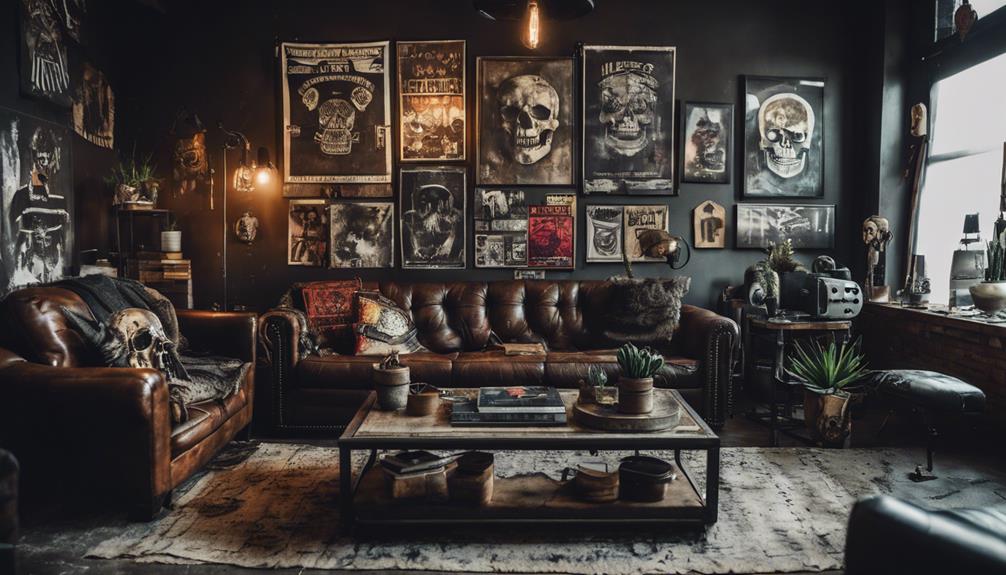
To really capture the essence of grunge decor, you'll want to showcase vintage band posters that nod to your musical influences.
A rustic woven wall tapestry adds texture and warmth, while a vintage leather travel trunk can serve as both a stylish storage solution and a conversation starter.
These decorative elements not only enhance your space but also reflect your unique personality and style.
Vintage Band Posters
Vintage band posters bring a nostalgic vibe to your grunge room, celebrating the rebellious spirit of iconic 90s rock music. These posters not only pay tribute to legends like Nirvana and Pearl Jam but also embody the essence of the grunge aesthetic.
To truly enhance your space, consider sourcing authentic vintage posters from thrift stores, flea markets, or online auctions. Each find offers unique designs and historical significance that elevate your decor.
Don't be afraid to get creative with how you display these treasures. Mismatched frames or unconventional mounting methods, like clipboards and washi tape, contribute to an eclectic and laid-back atmosphere. You can also incorporate posters of underground or lesser-known bands to showcase your individuality and depth of music taste, aligning perfectly with the grunge ethos of counterculture.
For a cohesive yet dynamic gallery wall, position your vintage band posters alongside other decor elements, such as graffiti art or distressed furniture. This combination creates a vibrant and authentic representation of the grunge style, making your room not just a space to live in but a true reflection of your unique personality and musical passion.
Vintage Leather Travel Trunk
A striking vintage leather travel trunk can instantly elevate your grunge room, adding a touch of history and character with its unique textures and rich patina. These trunks often come adorned with unique details like brass hardware, leather straps, and intricate stitching. Not only do they serve as functional storage, but they also act as eye-catching decorative elements.
Incorporating a vintage leather trunk enhances the eclectic vibe of your space. You can use it as a coffee table or bedside table, bringing both practicality and style to your room while keeping that rugged aesthetic intact. Imagine placing a few quirky accessories or layered textiles on top, creating a stunning focal point that draws the eye.
Finding a vintage leather trunk can be a fun adventure. Check out thrift stores, flea markets, or online marketplaces to discover a piece that resonates with your personal style. Each trunk tells its own story, making it a perfect addition to your grunge decor.
Rustic Woven Wall Tapestry
Rustic woven wall tapestries add a unique layer of texture and warmth to your grunge-themed room, creating a cozy and inviting atmosphere. These tapestries often showcase intricate designs inspired by nature, tribal motifs, or abstract art, making them versatile decorative elements that enhance your space's overall aesthetic.
Choosing a large woven tapestry can serve as a stunning focal point on a feature wall, drawing attention and providing a striking contrast against raw materials like brick or concrete. When you opt for handcrafted tapestries made from natural fibers like wool or cotton, you embrace the grunge ethos by highlighting artisanal craftsmanship and sustainable materials.
To elevate the grunge look, mix different textures in your decor. Pairing a woven tapestry with metal accents or distressed wood enhances the layered appearance characteristic of grunge design. This combination not only adds depth and visual interest but also creates a harmonious balance between rustic warmth and edgy styles.
Incorporating a rustic woven wall tapestry into your decor won't only wow your guests but also give your space a unique personality that reflects your taste.
Flooring

When it comes to flooring in your grunge-inspired space, consider options that add both character and texture.
Weathered brick pavers, textured vinyl plank flooring, and salvaged pallet wood flooring can all contribute to that edgy, vintage vibe you're aiming for.
Each choice brings a unique touch, so think about how they'll complement your overall decor.
Weathered Brick Pavers
Weathered brick pavers bring a rugged charm to your space, perfectly enhancing the grunge decor aesthetic with their unique textures and colors. These pavers offer an authentic look that adds character to both indoor and outdoor areas, making them a versatile flooring solution for your home.
The natural variations in color and texture found in weathered brick pavers contribute to a distinct and personalized feel, ensuring that your flooring stands out. Plus, their durability makes them an excellent choice for high-traffic areas, maintaining style without sacrificing functionality.
When you incorporate weathered brick pavers, you create a warm and inviting atmosphere that balances the harsher elements of grunge decor. The earthy tones and textures of the pavers can soften a space, allowing you to embrace the edgy vibe while still making it feel cozy.
With low maintenance requirements, these pavers not only look great but also save you time and effort. So, if you're looking to elevate your grunge room decor, consider adding weathered brick pavers to your flooring for a stylish, vintage touch that will wow everyone who enters your space!
Textured Vinyl Plank Flooring
Textured vinyl plank flooring offers a stylish and practical solution for achieving the perfect grunge aesthetic in your space. It mimics the look of natural materials like wood and stone while providing a durable, low-maintenance surface. With a range of designs, you can choose options that feature distressed finishes and earthy tones, enhancing the rugged vibe of your room.
One of the standout features of textured vinyl planks is their water resistance, making them ideal for high-traffic areas or spots prone to spills—perfect for a functional grunge environment. Plus, they're softer underfoot compared to traditional hardwood or tile, adding an unexpected comfort to your edgy decor.
What's more, installation can be a simple DIY project. This means you can create personalized layouts and designs that reflect your unique style within the grunge framework.
Whether you're looking to revamp a small nook or an entire room, textured vinyl plank flooring is an excellent choice that balances aesthetic appeal with practicality. You'll love how it transforms your space while standing up to the demands of daily life.
Salvaged Pallet Wood Flooring
Salvaged pallet wood flooring brings an eco-friendly and unique charm to your space, transforming discarded materials into a stunning feature. Sourced from shipping pallets that might otherwise end up in landfills, this flooring option is both cost-effective and sustainable. Each pallet has its own distinct aging, color, and texture, infusing your room with character that perfectly complements the grunge aesthetic.
Installing pallet wood flooring requires some preparation. You'll need to sand and seal the wood to guarantee durability and prevent splinters, while also achieving a smooth finish. The natural variations in color and grain create a visually interesting and rustic look, making it an ideal choice for layering with other textures in your decor.
To keep your pallet wood flooring looking its best, regular cleaning and the application of protective finishes are crucial. This not only preserves its raw and distressed appeal but also enhances its longevity. With proper care, salvaged pallet wood flooring can become a lasting centerpiece in your grunge-inspired room, adding an edgy flair that's sure to wow everyone who steps inside.
How Can I Incorporate Vaporwave Room Decor Ideas into a Grunge Room Design?
To incorporate vaporwave room decor ideas into a grunge room design, you can add elements like neon lights, retro technology, and pastel color palettes. Consider incorporating geometric shapes and ’90s inspired artwork for a retro-futuristic vibe. Mix in some vintage furniture and create a space that blends the best of both aesthetics.
Conclusion
Incorporating grunge room decor can transform your space into an edgy and stylish haven that wows everyone who steps inside.
By focusing on key elements, essential fixtures, unique lighting, and striking decorative pieces, you'll create a vibe that's authentically you.
Don't forget the flooring, as it ties everything together.
Embrace the raw, artistic feel of grunge, and let your personality shine through.
With these ideas, your room will truly stand out and make a lasting impression!
